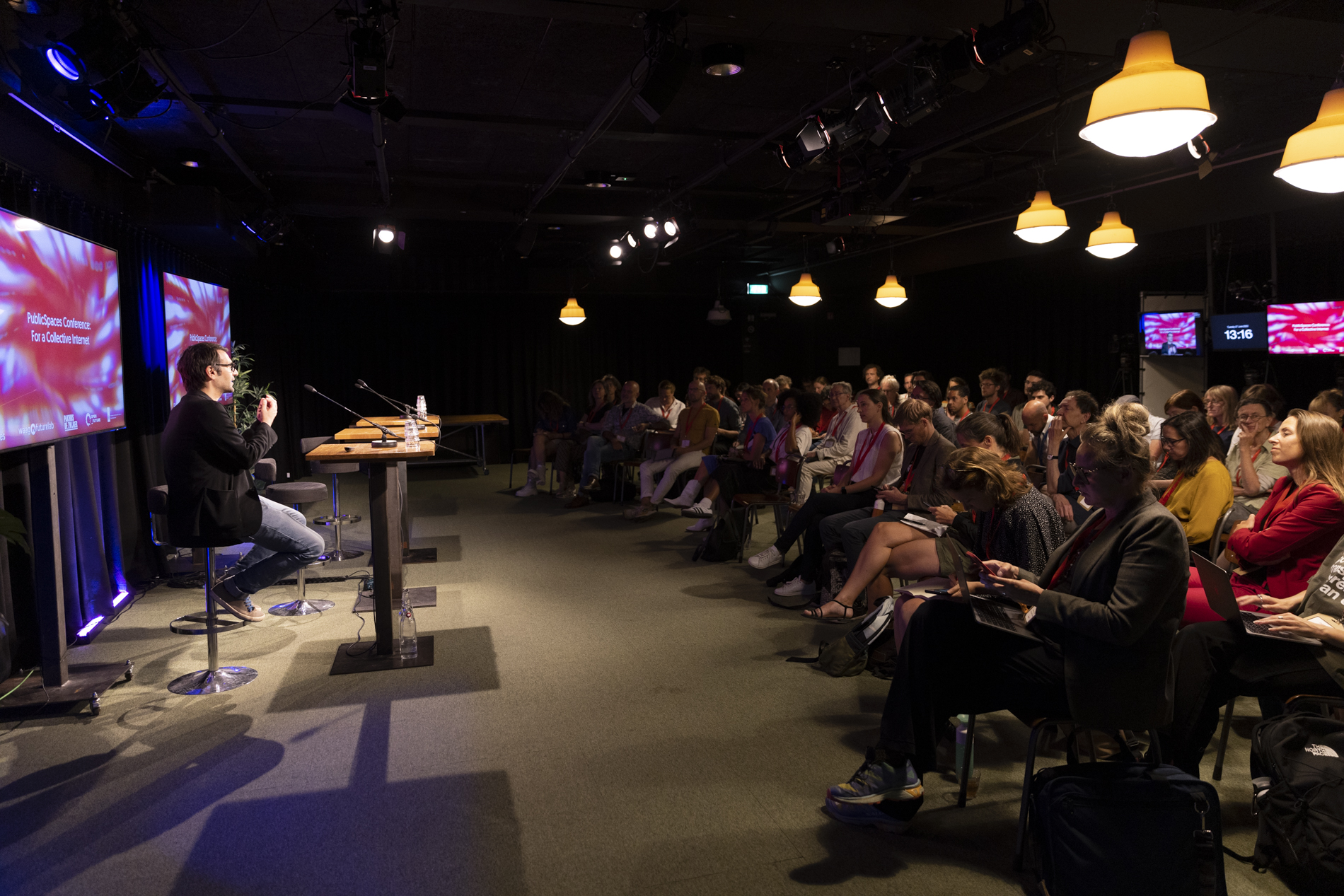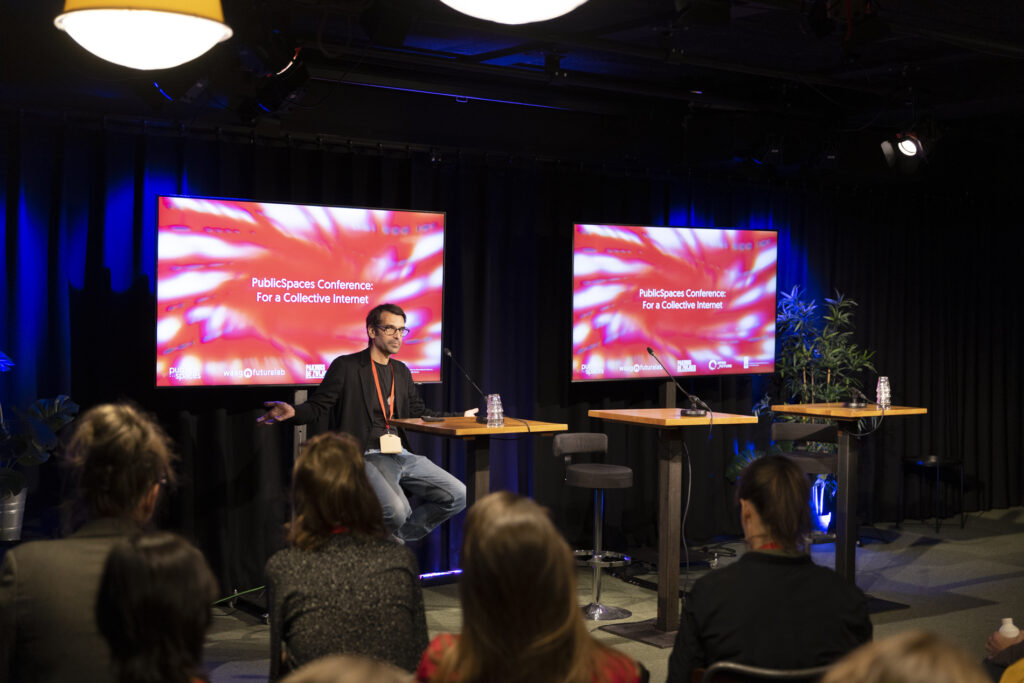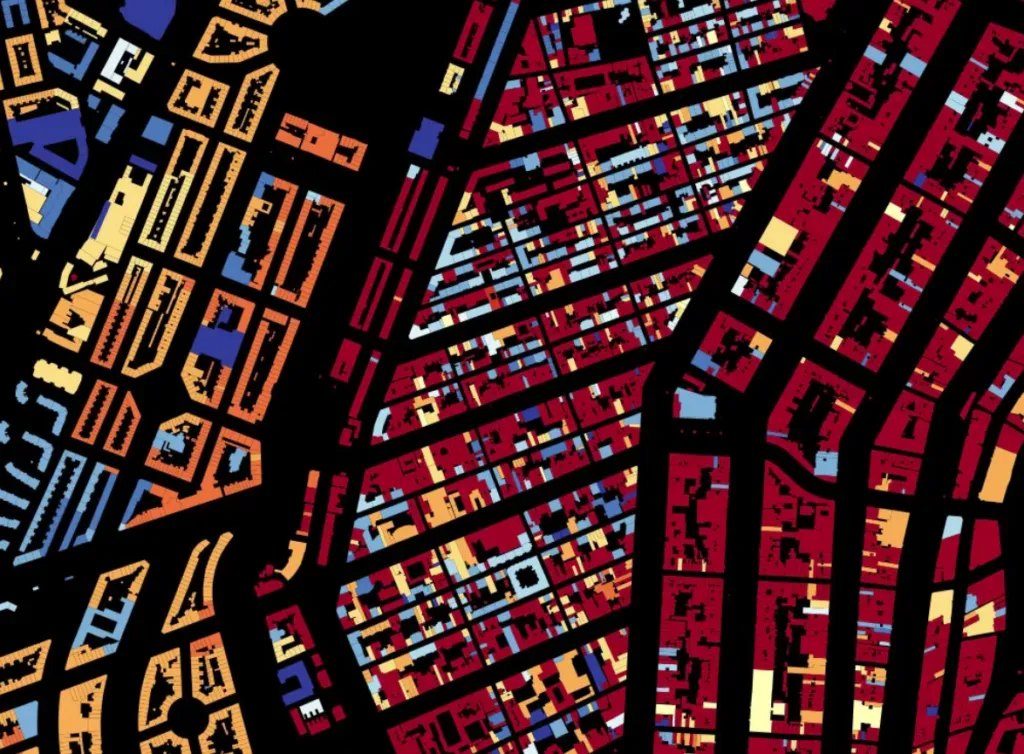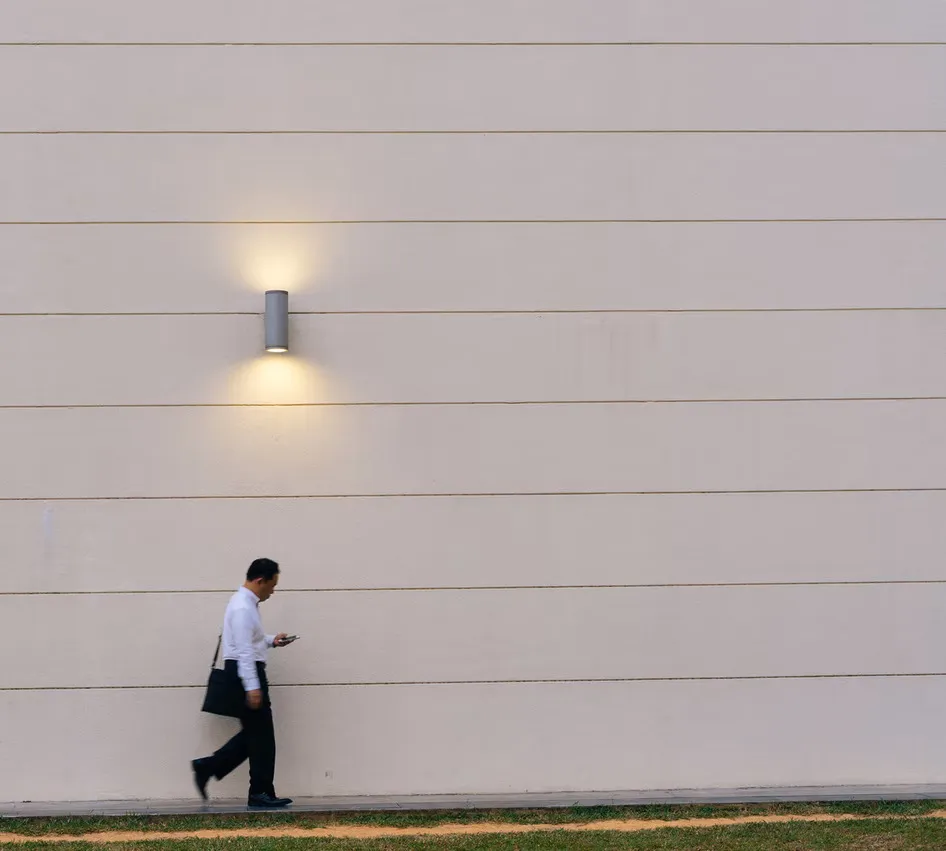An abundance of lines, arrows, symbols, process diagrams and small descriptions entangled in one large network is displayed on giant black-and-white screens. These maps are the result of the cartographic research of Vladan Joler. Last June, the professor and founder of SHARE Foundation, was part of the PublicSpaces Conference during the session ‘New Extractivism’, named after his eponymous cartographic work. He describes this piece as ‘an assemblage of concepts and allegories’ which visualises the algorithms of social media, involved labour relations, and environmental and behavioural surplus extraction. It explains the power processes of social media from the screen all the way to the extraction of natural resources by underpaid labour, all part of what he calls ‘digital colonialism’ or ‘new extractivism’.
PublicSpaces spoke to the artist after his session to reflect on it and the discussions that followed. A conversation unfolded on the activistic role of an artist, the pros and cons of cartographic research and some of the many concepts that are part of ‘New Extracivism’.

Hello Vladan, hope you enjoyed your session! Could you give a short recap?
‘The starting point was one of my maps, ‘New Extractivism’. It’s the weirdest map that I made. Most of them map invisible infrastructures and power relations within those infrastructures. This map is a bit different because it tries to visualise different concepts and ideas, mostly from media theory or philosophy. So, it’s more like a meta map. During the session, this map was explained via the supporting video and after that, a panel discussion took place around topics that related to the map. The map is dense with a lot of issues visualised, so there is a lot to discuss.’
‘I’m acting as an investigator more than someone who can provide solutions’
What was that discussion like?
‘I enjoyed it a lot. My maps visualise systems and the problems within those systems, and often, just like this time, I get the question of why I don’t offer any solutions to these issues. This is what I’m usually failing to answer. It sounds maybe weird, but I don’t see that as my goal, or even as a possibility to do. I’m acting as an investigator more than someone who can provide solutions. I don’t know enough to provide technological solutions and fix the problems. And maybe that is interesting, not to know.’
You are okay with not knowing?
‘Yes, and maybe one day I will be brave enough to try to give some kind of solution. But right now, I’m still trying to grasp those systems and investigate the multi-dimensional complexities of them. I bet some of those maps are useful for people, but maybe not this one. ‘Anatomy of an AI System’ or ‘Facebook Algorithmic Factory’ are maps that people actually use for workshops or policymaking.’

Is that why you create these maps? To inform people about all these structures rather than change them?
‘We (Share Lab, Kate Crawford, Matteo Pasquinelli and other experts), didn’t start with a clear idea of what we wanted to achieve with it. It started with the question: what is the smallest thing in this complex system that we want to grasp? The answer was the internet packet. We followed this internet packet and started to ask more and more questions. We were investigating the subject primarily at first. Visualising it by mapping came after and is used as a tool to understand the matter. It’s a visualisation and documentation of the investigation. But the maps also became objects of interest in many different contexts, such as the art context, educational context, or policy context. I never intended them to be what they are now, but I’m not complaining.’
And now people want to use the maps? But at the same time, you can’t guarantee the maps will help them?
‘Some people find them really useful. And the maps do help to speak about all these complex dimensions of technology. But I found my role limited still, even though it is very complicated and time-consuming to create these maps. I usually spend one or two years drawing one map. At the same time, developments are happening so fast and there are micro-trends in everything. In policy, everything is about AI and algorithmic transparency right now, but we never managed to completely solve any of those issues. In that sense, cryptography can be helpful to deeply investigate this, but not to find solutions in itself.’
That’s interesting. Technology is indeed changing very rapidly and maps may not be able to keep up as they are static visualisations of a moment in time.
‘Indeed. We are facing systems that are produced and maintained by thousands and thousands of hyper-skilled people. Those infrastructures and relations are evolving fast. The map is a static thing and a vague representation of complexity. They were basically never completely true and they can not be. But I still think it’s really important that we are at least trying to picture the problem – this is the only way for us to understand those systems.’

Why do you choose maps and not, for instance, words like written text to explain the outcomes of your investigation?
‘I do use some kind of combination because each of those maps is followed by an essay which gives you guidelines on how to read and understand the map. But cartography feels like a skill that I have developed over time and which is an easier language for me to use. In a way, I feel like maps are the same storytelling devices as texts, which can also be deceiving and playful.’
These maps are not objective representations?
‘Never. They pretend to be that though, but in most cases they are coming from the position of power, saying this is my kingdom, this is how the world looks like. There is no natural map and every map is a redaction of reality. Redacting means there is a choice. This is the storytelling part of cartography, it’s the choice of what you redact, and in which way you redact through your language.’
‘When we move, we are leaving a digital trace, which means that our movement is a form of labour’

The map ‘New Extractivism’ was just presented through a video, guided by a voice-over explaining the map, touching upon a lot of different concepts. What was striking was the part where you describe how internet users are all stuck in their own cave (Plato’s concept), orchestrated like a surveilled panopticon (Foucault), where they face the wall (which represents screens with content moderated by algorithms). Their shadow is the ‘digital shadow’ consisting of ‘user behaviour extraction’ surveilled by the central tower in the middle.
‘Yes, exactly. That map is an assemblage of different concepts and theories. So it’s basically a collection of footnotes. The other maps are different. This one is theoretical and ethical, the others are trying to visualise the complexity of infrastructures more than this one. And I did it just for me basically, because I enjoy making it.’
Sounds also a bit selfish!
‘Well, how can you pretend to explain something to other people if you…’
… are not curious yourself?
‘Yeah! I think what I’m allergic to is this culture in which you pretend to know everything and sell your product as an expert presenting it to be the best product in the world. I’m not a big fan of that. And in a sense, my work is merely an invitation to make your own map of the world around you.’
That’s a nice idea!
Let’s go over the main concept of the map. Could you once more explain new extractivism?
‘Extractivism is a process that is dating back probably hundreds of years in which one group of people or a nation extracts materials or human labour from another place. So, it is usually related to colonialism. In ‘Anatomy of an AI System’, we explored this extended anatomy of one object [an AI-system] and tried to understand the beginning and end of this process. We started with the [physical] elements extracted through mine excavation and labour exploitation. All the technological devices that we use are the end product of these extraction processes, in which you are indirectly destroying nature or exploiting low-paid workers.’
‘In the work ‘New Extractivism’ you can see the same thing. All of those devices are still devices, but the map shows another layer of them. These extractivist processes are not just extracting human labour and materials like metals. It also entails the extraction of our bodies [when we use these technological devices]. When we move, we are leaving a digital trace, which means that our movement is a form of labour where we are producing resources on many levels. This results in an emotion economy or an attention economy. Looking at something [a screen] has become a form of labour that is being extracted.’
You call this behavioural surplus?
‘It’s a term from Shoshana Zuboff, from her book ‘The Age of Surveillance Capitalism’. She explains how behaving has become a form of labour creating a digital surplus that is surveilled by technology. You are the resource, but you’re not getting paid.’
Would an example of that be a big tech company like Meta measuring how long you look at a certain Instagram post?
‘Indeed.’


Another concept you use is the gravity of the black hole that people get drawn into, not being able to escape social media. How does one resist this force?
For the exhibition series titled ‘New Extractivism’ at the Axioma Gallery in Ljubljana, Felix Stadler used the term ‘escape velocity’ in his essay ‘Escape Velocity. Computing and the Great Acceleration’. This term fits really well in the context of the black hole as an opening metaphor in my ‘New Extractivism’ map.
What would another solution be?
‘Rethinking the core values of our economic systems in general. It’s not a design problem, it’s a social problem which is fundamental and a few hundred years old. Think of capitalism and colonialism. If you want to fix this extended anatomy of devices, you need to fix the ties between people working in mines in Congo and people exploiting them. It goes deeper than the surface of the phone or any kind of software solution. It’s a social problem. And there is no easy fix.’
‘We ended up in a crazy version of the internet instead. The digital information from our bodies has become the main game.’
What would be the ideal online world for you, then?
‘I’m fond of the possibilities that we had in the past. The infrastructure of the internet, the core rules back then allowed for a completely different scenario that we are seeing now. It gave us the possibility that each node, each computer connected to the network, has the same power.’
What do you mean by nodes?
‘A node is a dot in the universe of the internet. Somehow we managed to transform the internet into a highly centralised place. It could have been a fantastic public library in which you have access to everything. We ended up in a crazy version of the internet instead. The digital information from our bodies has become the main game.’
So, would you like to go back to that ideal situation from the past?
‘We had a lot of possibilities to create something else and we still have a chance, I think. A chance to create these kinds of public spaces, a public infrastructure. But it also raises questions, like who is running the public? I’m from Serbia, and we have state-owned telecommunications operator Telekom Srbija, for example. But at the same time, this company is very untransparent and corruptive, because the government is corrupt. So you need a transparent and fair government for this.’
Last question! Do you consider yourself an activist next to an investigator?
‘I consider myself an activist for a long time, but maybe not an active activist. My maps are a form of activism in a sense; my own version of it.’
And that version is mapping, exploring and explaining?
‘Yes, and then other people can use the result for their types of activism.’
In this ‘aftertalk’ series, we publish three interviews with speakers from the PublicSpaces Conference 2023 that took place last June. Read our interview with cultural sociologist Siri Beerends here (Dutch only). The last aftertalk with writer Levien Nordeman on his opening appears end-August (Dutch only).



